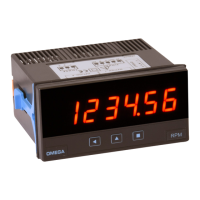Alarm 1
Setpoint
Hysteresis
Setpoint 2
Acve
Type of alarm
Delay 0
Delay 1
Menu for Alarm 2, at modules R2, R4 and R6
Factory
conguraon
Version
Menu for Alarm 3, at modules R4 and R6
Menu for Alarm 4, at modules R4 and R6
Menu for Alarm 5, at modules R6
Menu for Alarm 6, at modules R6
2.6.1 Conguraon menu
To congure alarm 1, access the ‘Alarm 1’ (‘ALr1’) menu and cong-
ure the following parameters : To congure alarms 2, 3, etc, access
the corresponding menu entries.
• select ‘Acve’ (‘Act’) to ‘on’
• at ‘Alarm type’ (‘TypE’) select the maximum alarm (‘MAX’) or
minimum alarm (‘MIn’). The maximum alarm (or type alarm) ac-
vates when display value is higher (or lower) than the setpoint
value.
• at ‘Setpoint’ (‘SEt’) enter the alarm acvaon value.
• congure the hysteresis value at ‘Hysteresis’ (‘hySt’). The hyster-
esis applies to the deacvaon process of the alarm. The alarm de-
acvates when the reading has passed the setpoint value plus the
hysteresis value.
• at ‘Delay 0’ (‘dEL.0’) assign the delay to be applied before alarm
acvaon. The acvaon delay starts counng when the setpoint
value is passed. Congurable from 0.0 to 99.9 seconds.
• at ‘Delay 1’ (‘dEL.1’) assign the delay to be applied before alarm
deacvaon. The deacvaon delay starts counng when the set-
point value plus the hysteresis value, is passed. Congurable from
0.0 to 99.9 seconds.
• to acvate the second setpoint, acvate ‘Setpoint 2’ (‘SEt2’) to
‘on’ and then congure the desired setpoint value. Second setpoint
allows for windowed alarms. The rst setpoint acvates the alarm,
and the second setpoint deacvates the alarm (conguraon for
‘Alarm as maximum’ type of alarm). Second setpoint must always
be higher in value than the rst setpoint.
2.6.2 Factory conguraon
Factory conguraon for alarms 1, 2, 3, 4, 5 and 6
‘Acve on’
‘Type de maxima’
‘Setpoint 1 1000’
‘Setpoint 2 2000’
‘Setpoint 3 3000’
‘Setpoint 4 4000’
‘Setpoint 5 5000’
‘Setpoint 6 6000’
‘Hysteresis 0 counts’
‘Acvaon delay 0.0 counts’
‘Deacvaon delay 0.0 seconds’
‘Setpoint 2 O’

